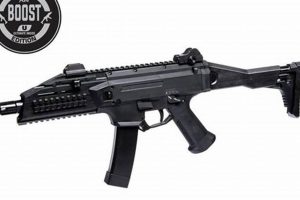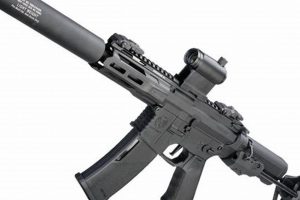The term designates a type of launcher commonly employed in airsoft simulations. These devices, often modeled after real-world grenade launchers, are designed to fire projectiles, typically 40mm airsoft grenades, which disperse multiple BBs over a designated area. These launchers can be standalone units or attachments for airsoft rifles, offering players a means to engage multiple opponents simultaneously or to dislodge entrenched adversaries.
The significance of these devices lies in their ability to provide a force multiplication effect on the airsoft field. Their utilization introduces a tactical dimension, enabling players to execute area denial strategies and suppress enemy positions more effectively than with standard airsoft rifles. Historically, the adoption of these launchers has mirrored the evolution of airsoft tactics, reflecting a trend toward more realistic and strategic gameplay.
This article will now delve into specific models, operational considerations, and safety protocols associated with the use of these launchers within the airsoft context. The discussion will further explore the tactical advantages and potential drawbacks of incorporating these devices into standard airsoft loadouts, providing a comprehensive understanding of their role in the sport.
Airsoft GL Usage Tips
The following tips are designed to enhance the effectiveness and safety of launcher use in airsoft scenarios. Proper technique and adherence to safety protocols are paramount for responsible operation.
Tip 1: Utilize Appropriate Projectiles: Employ only projectiles specifically designed for airsoft launchers. The use of unauthorized or modified projectiles can result in damage to equipment or injury to personnel.
Tip 2: Maintain a Safe Firing Distance: Adhere to minimum engagement distances specified by field regulations. Firing at close range can cause unnecessary pain or injury, especially with high-velocity projectiles.
Tip 3: Prioritize Target Identification: Ensure positive identification of the intended target before firing. Indiscriminate firing can lead to accidental hits on teammates or non-combatants.
Tip 4: Practice Trajectory Compensation: Launcher projectiles exhibit significant drop over distance. Practice estimating projectile trajectory to ensure accurate target engagement at varying ranges.
Tip 5: Securely Mount and Maintain the Launcher: Ensure the launcher is properly mounted to the airsoft rifle, if applicable, and regularly inspect all components for wear or damage. A loose or malfunctioning launcher presents a safety hazard.
Tip 6: Observe Field Safety Rules: Always comply with the specific safety regulations of the airsoft field, including mandated eye protection and projectile velocity limits.
Tip 7: Communicate Intended Targets: Clearly communicate intended targets to teammates to avoid friendly fire incidents, especially in close-quarters combat situations.
Effective and safe utilization hinges on understanding the device’s capabilities and limitations, as well as adhering to established safety procedures. Responsible employment enhances gameplay and minimizes the risk of injury.
The subsequent sections will address specific launcher models and offer guidance on selection and maintenance for optimal performance.
1. Projectile Velocity
Projectile velocity represents a critical performance parameter for airsoft grenade launchers, directly influencing their effective range, impact force, and adherence to safety regulations. The velocity, typically measured in feet per second (FPS), determines how quickly a projectile travels from the launcher to its target.
- FPS Limits and Safety
Airsoft fields impose strict FPS limits on all airsoft guns, including grenade launchers, to ensure player safety and minimize the risk of injury. These limits vary depending on the field and the type of airsoft gun. Exceeding the FPS limit can result in expulsion from the field. Lower FPS values generally reduce the potential for injury but also decrease the effective range of the launcher.
- Projectile Mass and Energy
Projectile velocity is directly related to the kinetic energy of the projectile. Kinetic energy, calculated as 1/2 mass velocity^2, represents the energy the projectile possesses due to its motion. Even at lower FPS values, heavier projectiles can deliver a significant impact force. Field rules often regulate both FPS and the maximum allowable projectile weight to limit overall kinetic energy.
- Trajectory and Range
Higher projectile velocities generally result in flatter trajectories and increased range. However, air resistance and gravity still affect the projectile’s path. Calculating projectile drop becomes essential for accurate targeting at longer distances. Chronographs are commonly used to measure projectile velocity and ensure compliance with field regulations.
- Gas Pressure and Power Source
The projectile velocity is determined by gas pressure, whether the launcher uses compressed gas or a spring mechanism. Consistent gas pressure is essential for achieving consistent projectile velocities. Fluctuations in gas pressure can lead to variations in FPS, affecting accuracy and potentially causing the launcher to fall out of compliance with field regulations.
In summary, projectile velocity serves as a key metric governing the performance and safety of airsoft grenade launchers. Understanding its relationship with projectile mass, kinetic energy, range, and the power source is crucial for responsible and effective utilization of these devices in airsoft scenarios. Adhering to FPS limits and employing appropriate safety precautions are paramount for ensuring a safe and enjoyable airsoft experience.
2. Effective Range
Effective range, when discussing airsoft grenade launchers, dictates the practical usability of the device on the field. It represents the distance at which a projectile fired from the launcher can reliably and accurately impact a target area, delivering its payload of BBs. The effective range is not merely a measure of maximum possible distance; instead, it considers factors such as projectile drop, wind resistance, and the dispersion pattern of the BBs upon impact. A launcher with a theoretically long maximum range may possess a limited effective range if the BBs scatter too widely or the projectile’s trajectory becomes unpredictable beyond a certain point.
The significance of effective range stems from its direct impact on tactical deployment. A greater effective range allows a player to engage opponents from a safer distance, providing a tactical advantage in suppressing fire or clearing rooms. However, a longer range does not automatically translate to superior performance. Terrain, weather conditions, and the specific type of projectile used all influence the achievable effective range. For instance, wind can significantly alter the trajectory of a lightweight BB, reducing the accuracy and effective range. Similarly, firing into dense foliage may impede the projectile’s flight, limiting its ability to reach the intended target.
The relationship between effective range and successful deployment of an airsoft grenade launcher is crucial. Players must understand the practical limitations of their equipment and adapt their tactics accordingly. Prioritizing accuracy and controlled dispersion within the effective range is often more beneficial than attempting shots at maximum distance. Effective range dictates the conditions under which the launcher can be used effectively and safely, requiring users to adapt their strategies based on the specific environment and opposition.
3. Gas Consumption
Gas consumption is a critical performance factor directly influencing the operational efficiency and practical usability of airsoft grenade launchers (GLs). These devices rely on compressed gas, typically green gas or CO2, to propel projectiles. The rate at which a launcher consumes this gas directly determines the number of shots a user can fire before requiring a refill. A high gas consumption rate necessitates frequent reloading, disrupting gameplay and potentially compromising tactical effectiveness. The physics are straightforward: each launch of a grenade expels a certain volume of compressed gas to propel the projectile forward. The greater the volume of gas expelled per shot, the quicker the gas reservoir is depleted. For instance, some high-powered launchers, designed for long-range engagements, may consume significantly more gas per shot compared to lower-powered, close-quarters models. This differential directly impacts their respective operational durations on the field.
The practical significance of understanding gas consumption lies in its impact on tactical planning and resource management during airsoft games. Players must carefully consider the gas consumption rate of their launchers when selecting their loadout and developing their strategies. For example, a player participating in a long, drawn-out scenario might prioritize a launcher with lower gas consumption, even if it means sacrificing some power or range. Conversely, a player engaged in a quick, high-intensity firefight might opt for a high-powered launcher, accepting the trade-off of higher gas consumption and the need for more frequent refills. This understanding also informs the selection of appropriate gas canisters and the number of canisters to carry into the field, directly impacting mobility and carrying capacity. Neglecting to account for gas consumption can lead to unexpected reloads during critical moments, potentially jeopardizing mission success.
In conclusion, gas consumption is an intrinsic characteristic of airsoft grenade launchers that significantly impacts their performance, practicality, and tactical application. A thorough understanding of this parameter is essential for responsible and effective utilization of these devices in airsoft scenarios. Challenges in managing gas consumption can be mitigated through careful selection of launchers, gas types, and tactical approaches. Further research and development into gas-efficient designs would undoubtedly enhance the overall usability and effectiveness of airsoft grenade launchers, making them an even more valuable asset on the airsoft field.
4. Mounting Compatibility
Mounting compatibility represents a critical factor in the effective integration of an airsoft grenade launcher (airsoft GL) into a player’s loadout. It refers to the physical interface and mechanical compatibility between the launcher and the host airsoft weapon, typically a rifle. A mismatch in mounting systems renders the launcher unusable or, at best, compromises its stability and accuracy. Several mounting standards exist, with Picatinny rails (MIL-STD-1913) being the most prevalent. Grenade launchers designed for Picatinny compatibility can be readily attached to a wide range of airsoft rifles equipped with corresponding rail sections. Other mounting systems, such as those specific to certain rifle models or utilizing proprietary interfaces, necessitate careful matching of the launcher to the host weapon. The failure to ensure proper mounting compatibility can result in a loose or insecure attachment, leading to inaccurate shots, potential damage to the launcher or rifle, and increased risk of accidents during gameplay.
The importance of mounting compatibility extends beyond mere physical attachment. A secure and properly aligned mount ensures that the launcher’s sights or aiming devices are accurately zeroed with the rifle’s optics. This alignment is crucial for precise target acquisition and engagement. Furthermore, a stable mount minimizes recoil-induced movement, improving shot consistency. Several real-world examples illustrate the significance of mounting compatibility. Players who attempt to adapt incompatible launchers to their rifles often encounter issues with stability, alignment, and overall performance. Conversely, using a launcher specifically designed for a particular rifle model, with a compatible mounting system, results in a seamless and integrated setup, enhancing both accuracy and ease of use. The practical significance of this understanding lies in the ability to select and configure equipment effectively, maximizing performance and minimizing potential issues on the airsoft field.
In summary, mounting compatibility is an indispensable component of airsoft GL integration. Ensuring a proper match between the launcher and the host weapon is essential for stability, accuracy, and overall performance. The challenges associated with incompatible mounting systems can be mitigated through careful research, selection of compatible equipment, and adherence to established mounting standards. A comprehensive understanding of mounting compatibility enhances the player’s ability to effectively utilize airsoft grenade launchers, contributing to a more successful and enjoyable airsoft experience.
5. Tactical Application
Tactical application, in the context of airsoft grenade launchers (airsoft GLs), encompasses the strategic deployment and utilization of these devices to achieve specific objectives within simulated combat scenarios. Understanding the diverse tactical applications of airsoft GLs is crucial for effective integration into airsoft strategies.
- Area Denial
Area denial involves using airsoft GLs to saturate a specific area with BBs, discouraging or preventing enemy movement through that zone. This tactic is effective in limiting enemy flanking maneuvers, controlling chokepoints, and protecting defensive positions. An example includes deploying a burst of grenades into a doorway or hallway to impede enemy advancement during a building assault. The success of area denial depends on accurately estimating the area of effect and timing the grenade deployment to maximize disruption.
- Suppressive Fire
Suppressive fire aims to reduce the enemy’s ability to effectively return fire by overwhelming their position with a barrage of BBs. Airsoft GLs are well-suited for this purpose, providing a high volume of projectiles that force opponents to seek cover. For example, a squad might use coordinated GL fire to suppress an enemy bunker, allowing friendly forces to advance under cover. The effectiveness of suppressive fire hinges on maintaining a sustained rate of fire and accurately targeting enemy positions.
- Flushing Out Opponents
Flushing out opponents involves dislodging entrenched enemies from concealed positions, such as buildings or bunkers. Airsoft GLs can be used to deliver a high volume of BBs into these positions, forcing occupants to either relocate or risk being hit. An instance would be targeting a fortified building window with multiple grenades to force enemy players out into the open. The success of this tactic lies in anticipating enemy escape routes and coordinating with teammates to intercept them.
- Objective Control
Objective control entails using airsoft GLs to secure and maintain control of key objectives, such as flags or designated areas. By saturating the objective area with BBs, friendly forces can deter enemy attempts to seize or recapture it. For example, defending a capture point by periodically launching grenades to disrupt enemy approaches. Effective objective control requires coordinating GL fire with defensive positioning to create a layered defense.
The tactical application of airsoft GLs significantly expands the strategic possibilities in airsoft scenarios. Whether for area denial, suppressive fire, flushing out opponents, or objective control, understanding the capabilities and limitations of these devices allows players to integrate them effectively into their overall game plan. Skillful employment of airsoft GLs, combined with coordinated teamwork, greatly enhances a team’s ability to achieve victory.
Frequently Asked Questions
The following section addresses common inquiries concerning airsoft grenade launchers (airsoft GLs), providing concise and informative answers to facilitate a comprehensive understanding of these devices.
Question 1: What types of projectiles are compatible with airsoft GLs?
Airsoft GLs typically utilize 40mm airsoft grenades, designed to disperse multiple 6mm BBs upon impact. Specialized grenades firing foam rockets or other non-BB projectiles also exist, but their availability and field legality vary.
Question 2: What is the effective range of a standard airsoft GL?
The effective range depends on the model, gas pressure, and projectile type. However, a typical range of 20-50 meters is considered standard, with accuracy diminishing beyond this distance.
Question 3: What safety precautions are necessary when using airsoft GLs?
Mandatory eye protection is paramount. Minimum engagement distances, as dictated by field rules, must be observed to prevent injury. Projectile velocity limits must also be adhered to.
Question 4: How does gas consumption affect the performance of airsoft GLs?
High gas consumption necessitates frequent reloading, impacting gameplay continuity. Launcher selection should consider gas efficiency for prolonged engagements.
Question 5: Are airsoft GLs legal to own and use?
Legality varies by jurisdiction. Local laws and regulations must be consulted to ensure compliance. Certain areas may restrict ownership or usage.
Question 6: What are the primary maintenance requirements for airsoft GLs?
Regular cleaning, lubrication of moving parts, and inspection for damage are essential. Proper storage and handling contribute to longevity and optimal performance.
Understanding these fundamental aspects of airsoft grenade launchers is crucial for responsible and effective integration into airsoft gameplay.
The subsequent section will address advanced tactical considerations for airsoft GL deployment.
Conclusion
This exploration has detailed diverse aspects of airsoft GL systems, encompassing operational principles, performance metrics, tactical employment, and safety protocols. Emphasis has been placed on the importance of responsible usage, encompassing adherence to field regulations, understanding projectile dynamics, and prioritizing player safety.
The strategic deployment of airsoft GL devices continues to evolve within the airsoft community. Responsible employment and a commitment to safe practices will determine its sustained integration within the sport. Continued engagement with community guidelines, equipment maintenance, and proper training remain critical to ensuring a secure and rewarding experience.







